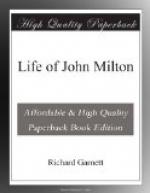With such earnest of a true vocation, Milton betook himself to retirement at Horton, a village between Colnbrook and Datchet, in the south-eastern corner of Buckinghamshire, county of nightingales, where his father had settled himself on his retirement from business. This retreat of the elder Milton may be supposed to have taken place in 1632, for in that year he took his clerk into partnership, probably devolving the larger part of the business upon him. But it may have been earlier, for in 1626 Milton tells Diodati—
“Nos quoque lucus habet vicina
consitus ulmo,
Atque suburbani nobilis umbra
loci.”
And in a college declamation, which cannot have been later than 1632, he “calls to witness the groves and rivers, and the beloved village elms, under which in the last past summer I remember having had supreme delight with the Muses, when I too, among rural scenes and remote forests, seemed as if I could have grown and vegetated through a hidden eternity.”
CHAPTER II.
Doctor Johnson deemed “the knowledge of nature half the task of a poet,” but not until he had written all his poetry did he repair to the Highlands. Milton allows natural science and the observation of the picturesque no place among the elements of a poetical self-education, and his practice differs entirely from that which would in our day be adopted by an aspirant happy in equal leisure. Such an one would probably have seen no inconsiderable portion of the globe ere he could resolve to bury himself in a tiny hamlet for five years. The poems which Milton composed at Horton owe so much of their beauty to his country residence as to convict him of error in attaching no more importance to the influences of scenery. But this very excellence suggests that the spell of scenery need not be exactly proportioned to its grandeur.
The beauties of Horton are characterized by Professor Masson as those of “rich, teeming, verdurous flat, charming by its appearance of plenty, and by the goodly show of wood along the fields and pastures, in the nooks where the houses nestle, and everywhere in all directions to the sky-bound verge of the landscape.” He also notices “the canal-like abundance and distribution of water. There are rivulets brimming through the meadows among rushes and water-plants; and by the very sides of the ways, in lieu of ditches, there are slow runnels, in which one can see the minnows swimming.” The distant keep of Windsor, “bosomed high in tufted trees,” is the only visible object that appeals to the imagination, or speaks of anything outside of rural peace and contentment. Milton’s house, as Todd was informed by the vicar of the parish, stood till about 1798. If so, however, it is very remarkable that the writer of an account of Horton in the Gentleman’s Magazine for August, 1791, who speaks of Milton with veneration, and transcribes his mother’s epitaph, does not




